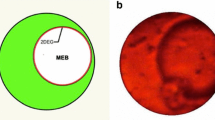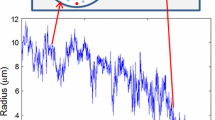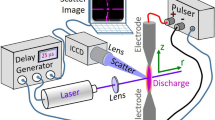Abstract.
The mechanism behind the intensity oscillations accompanying the flow of solid helium through a micron-sized orifice into vacuum, called the geyser effect, is investigated by measuring the pressure pulses at various locations in the entire flow system. The new results reveal that the source chamber pressure pulses have the same shape as the external detector pulses monitored in the previous experiments [G. Benedek et al., Phys. Rev. Lett. 95, 095301 (2005)]. New experiments in which the external gas reservoir is isolated from the pressure regulator provide direct information on the mechanism of the collapse leading to the geyser pulses. Thus each geyser pulse is triggered by the breakdown of a plug located upstream of the source chamber. The flow of liquid through the orifice determines the shape of the subsequent geyser pulse.
Similar content being viewed by others
References
E. Kim, M.H.W. Chan, Nature 427, 225 (2004)
E. Kim, M.H.W. Chan, Science 305, 1941 (2004)
J. Day, J. Beamish, Nature 450, 853 (2007)
M.W. Ray, R.B. Hallock, Phys. Rev. Lett. 100, 235301 (2008)
X. Lin, A.C. Clark, Z.G. Cheng, M.H.W. Chan, Phys. Rev. Lett. 102, 125302 (2009)
D.E. Galli, L. Reatto, J. Phys. Soc. J. 77, 111010 (2008)
S. Balibar, F. Caupin, J. Phys. Condens. Matter 20, 173201 (2008)
J. Saunders, Science 324, 601 (2009)
G. Benedek, F. Dalfovo, R. Grisenti, M. Käsz, J.P. Toennies, Phys. Rev. Lett. 95, 095301 (2005)
G. Benedek, R. Grisenti, J.P. Toennies, F. Dalfovo, J. Electron. Spectrosc. Relat. Phenom. 129, 201 (2003)
National Aperture, Inc, 16 Northwestern Drive, Salem, NH 03079 USA
Kistler Instruments (8408 Winterthur, Switzerland) high pressure quarz sensor type 601A with charge amplifier model 5015A
Kistler Instruments (8408 Winterthur, Switzerland) piezoresistive absolute pressure sensor type 4073A100 and piezoresistive amplifier model 4601A
E.R. Grilly, J. Low Temp. Phys. 11, 33 (1972)
I. Iwasa, K. Araki, H. Suzuki J. Phys. Soc. Jpn 46, 1119 (1979)
cL was set equal to the value of c33 from ultrasonic measurements by R.H. Crepeau, O. Heybey, D.M. Lee, S.A. Strauss, Phys. Rev. A 3, 1162 (1971 )
B.N.J. Persson, Sliding Friction (Springer, 1998), p. 150, Figure 7.39(f)
G. Benedek, A. Kalinin, P. Nieto, J.P. Toennies, to be published
Author information
Authors and Affiliations
Corresponding author
Rights and permissions
About this article
Cite this article
Benedek, G., Nieto, P. & Toennies, J. The Geyser effect in the expansion of solid helium into vacuum. Eur. Phys. J. B 76, 237–249 (2010). https://doi.org/10.1140/epjb/e2010-00207-2
Received:
Published:
Issue Date:
DOI: https://doi.org/10.1140/epjb/e2010-00207-2




